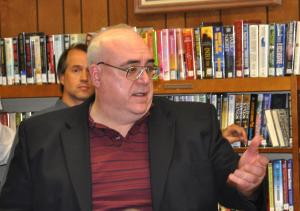Blood disease: No answer
www.tnonline.com/2012/sep/21/blood-disease-no-answer
Friday, September 21, 2012
By DONALD R. SERFASS dserfass@tnonline.com

DONALD R. SERFASS/TIMES NEWS A portion of the crowd at the Tamaqua Public Library on Thursday listens to an update on the status of a rare blood disease found in the local area in 2004.
A government agency provided a status update Thursday on research into a rare blood disease found in our area.
But the update left locals frustrated.
Joe Murphy, Hometown, voiced exasperation due to the slow pace of progress. Murphy represents the Citizens Advisory Committee and said he and his group would like to see improved flow of information and a more open approach.
“After six years, all I can say is where’s the beef,” said Murphy at the conclusion of an informal update provided by the Agency for Toxic Substances and Disease Registry (ATSDR).
The session drew over 50 concerned residents to the Tamaqua Public Library, where Lora Siegmann Werner and Dr. Elizabeth Irvin-Barnwell, both of the ATSDR, were on hand to respond to public questions. Also available were officials from the Pennsylvania Department of Health, the Department of Environmental Protection and several project partners.
The update included progress reports on 18 projects funded through $7.9M in government grants aimed at getting to the bottom of the cause of clusters of a disease that makes too many blood cells. The condition, polycythemia vera (PV), has been found at an alarming rate in Schuylkill, Carbon and Luzerne counties.
Among the new information provided by Irvin-Barnwell:
- 77 participants have been enrolled in an epidemiologic study through the University of Pittsburgh. The study compares the pattern of PV occurrences in the commonwealth.
- More accurate physician reporting of PV cases. This step is complete and the cases are undergoing internal quality control and data analysis.
- Physician education has been completed with regard to diagnosis, reporting and treating of PV cases.
- The Tri-County area case study is under way and 55 people with one of a number of slow-moving blood cancers have been recruited along with 473 people without the condition. Medical records are being examined for accuracy.
- A genetic study is under way with a review of blood samples from 39 volunteers to see if patients in the cluster area are genetically prone to develop PV. Gene profiling also is under way.
- Other studies under way include detection of a JAK2 mutation, recruitment for a tissue bank, and toxicology assay to evaluate whether 18 environmental contaminants can cause DNA damage.
- An air and water sampling plan has been finalized and samples are being collected. Air modeling is complete.
- Creation of a database for federal, state and other data relating to possible human exposures to contaminants from hazardous waste sites, industries, or businesses that release toxic substances has been completed. The data warehouse contains 100,000 samples and 2.5 million records for 2,700 substances.
- Environmental testing near the McAdoo Superfund site, three waste coal burning plants, and residential sampling have been collected and analyzed. The ATSDR is evaluating results.
- Murphy expressed concern that funding for the Citizens Advisory Committee was curtailed in January, 2010, and the ATSDR’s chief investigator, Dr. Vince Seaman, left for Nigeria in 2010 on a separate endeavor and is not due back until next year.

“Citizens have had a role in this … but we haven’t had a lot of money,” Joe Murphy, Hometown, addressing the public forum on polycythemia vera held at the Tamaqua Public Library. Funding for the citizens advisory group was cut in 2010.
Those setbacks, among others, have dealt a blow to local initiatives, said Murphy.
He is hoping the Betty Kester Alliance for a Healthy Future can step in to pick up the slack.
“Our goal is to continue to explore,” said Murphy.
“We’ll continue to have more of these updates,” says Dr. Irvin-Barnwell.
Kester and her husband, Lester, were Still Creek residents. Both developed PV. They are now deceased.
There have been 2,099 cases of PV reported in Pennsylvania. Of those, 227, or 10.8 percent, are found in Schuylkill, Carbon and Luzerne counties.

It appears pretty evident that serious illnesses in Tamaqua, Lansford, Coaldale and Summit Hill are being caused by chemical wastes in the many old dumpsites and mine tailings in the area. Are there plans to relocate residents from these toxic sites???
Janice England – It is evident to me from the statistics that there are serious illnesses in the area. What is not evident is what caused them. Scientific study of the problem with statistically significant sample sizes is necessary before we can really say one led to the other. I don’t mean to trivialize the diseases or the losses they have caused, but without knowing what other cancer risks may be present in the environment of those taken ill, we can be sure of the potential causes and how they interact.